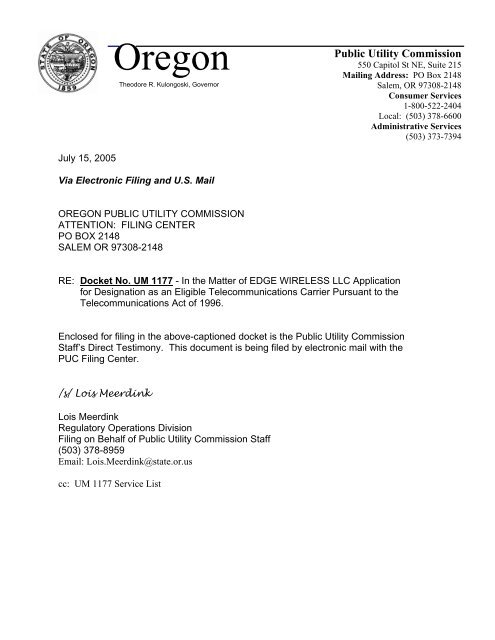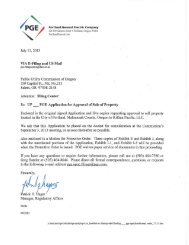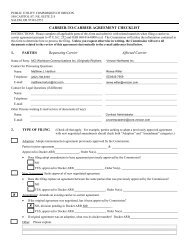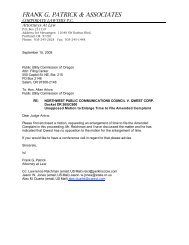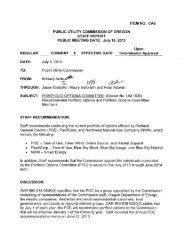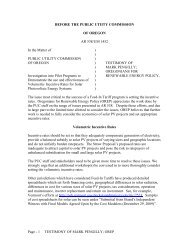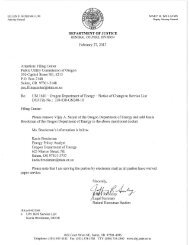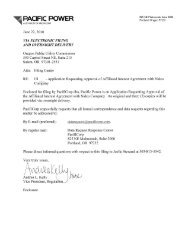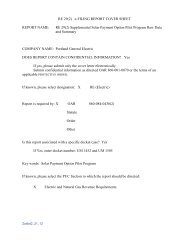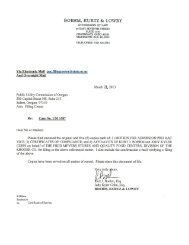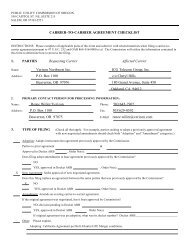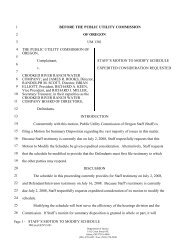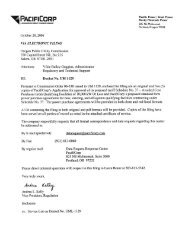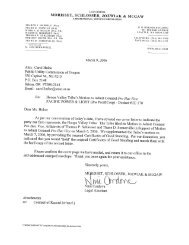UM 1177, TESTIMONY & EXHIBITS, 7/15/2005 - State of Oregon
UM 1177, TESTIMONY & EXHIBITS, 7/15/2005 - State of Oregon
UM 1177, TESTIMONY & EXHIBITS, 7/15/2005 - State of Oregon
Create successful ePaper yourself
Turn your PDF publications into a flip-book with our unique Google optimized e-Paper software.
<strong>Oregon</strong>Theodore R. Kulongoski, GovernorPublic Utility Commission550 Capitol St NE, Suite 2<strong>15</strong>Mailing Address: PO Box 2148Salem, OR 97308-2148Consumer Services1-800-522-2404Local: (503) 378-6600Administrative Services(503) 373-7394July <strong>15</strong>, <strong>2005</strong>Via Electronic Filing and U.S. MailOREGON PUBLIC UTILITY COMMISSIONATTENTION: FILING CENTERPO BOX 2148SALEM OR 97308-2148RE: Docket No. <strong>UM</strong> <strong>1177</strong> - In the Matter <strong>of</strong> EDGE WIRELESS LLC Applicationfor Designation as an Eligible Telecommunications Carrier Pursuant to theTelecommunications Act <strong>of</strong> 1996.Enclosed for filing in the above-captioned docket is the Public Utility CommissionStaff’s Direct Testimony. This document is being filed by electronic mail with thePUC Filing Center./s/ Lois MeerdinkLois MeerdinkRegulatory Operations DivisionFiling on Behalf <strong>of</strong> Public Utility Commission Staff(503) 378-8959Email: Lois.Meerdink@state.or.uscc: <strong>UM</strong> <strong>1177</strong> Service List
PUBLIC UTILITY COMMISSIONOF OREGON<strong>UM</strong> <strong>1177</strong>STAFF <strong>TESTIMONY</strong>OFKay MarinosIn the Matter <strong>of</strong>EDGE WIRELESS LLC Application forDesignation as an Eligible TelecommunicationsCarrier Pursuant to the Telecommunications Act <strong>of</strong>1996July <strong>15</strong>, <strong>2005</strong>
CASE: <strong>UM</strong> <strong>1177</strong>WITNESS: Kay MarinosPUBLIC UTILITY COMMISSIONOFOREGONSTAFF EXHIBIT 1Direct TestimonyJuly <strong>15</strong>, <strong>2005</strong>
Docket <strong>UM</strong> <strong>1177</strong>Staff/1Marinos/11234567891011121314<strong>15</strong>16171819202122Q. PLEASE STATE YOUR NAME, OCCUPATION, AND BUSINESSADDRESS.A. My name is Kay Marinos. I am a Senior Telecommunications Analyst in theTelecommunications Division <strong>of</strong> the Public Utility Commission <strong>of</strong> <strong>Oregon</strong>(Commission). My business address is 550 Capitol Street NE Suite 2<strong>15</strong>,Salem, <strong>Oregon</strong> 97301-2551.Q. PLEASE DESCRIBE YOUR EDUCATIONAL BACKGROUND AND WORKEXPERIENCE.A. My Witness Qualification <strong>State</strong>ment is found in Exhibit Staff/2.Q. WHAT IS THE PURPOSE OF YOUR <strong>TESTIMONY</strong>?A. I analyze the Second Amended Combined Application <strong>of</strong> Edge Wireless, LLC(Edge), in which Edge requests that the Commission designate it as eligible toreceive all available support from the federal Universal Service Fund (USF),and provide the Commission with my recommendation.Q. WHAT IS YOUR RECOMMENDATION?A. I recommend that the Commission grant the relief requested by Edge.Q. HOW IS YOUR <strong>TESTIMONY</strong> ORGANIZED?A. First, I discuss the background <strong>of</strong> this docket. More specifically, I describe theapplicant, the relief that is requested and some <strong>of</strong> the docket’s proceduralhistory. Second, I discuss the Commission’s authority to designate commoncarriers such as Edge as eligible to receive support from the USF, or as eligibletelecommunication carriers (ETCs). Third, I discuss the requirements for
Docket <strong>UM</strong> <strong>1177</strong>Staff/1Marinos/21234567891011121314<strong>15</strong>1617181920212223designation as an ETC. Finally, I address whether Edge has satisfied thoserequirements and provide my recommendation.BACKGROUNDQ. WHO IS EDGE?A. Edge is a Commercial Mobile Radio Service (CMRS) carrier providing“mobileservice” as defined in 47 U.S.C. § <strong>15</strong>3(27). Edge provides interstatetelecommunications services as defined in 47 U.S.C. § 254(d) and 47 C.F.R. §54.703(a). Edge is licensed to provide cellular service in <strong>Oregon</strong> in the BasicTrading Areas (BTAs) <strong>of</strong> Coos Bay 97, Roseburg 385, and the JosephineCounty portion <strong>of</strong> Medford 288. These BTAs are coextensive with theboundaries <strong>of</strong> Coos, Curry, Douglas and Josephine counties.Q. WHAT RELIEF DOES EDGE REQUEST IN THIS DOCKET?A. Edge requests ETC status throughout all the incumbent local exchange carrier(ILEC) wire centers that are included in its licensed cellular service area insouthwestern <strong>Oregon</strong>. The specific wire centers are identified in Exhibit B <strong>of</strong> itsJune 20, <strong>2005</strong>, Second Amended Combined Application. The incumbent LECsin these wire centers are Qwest Corporation (Qwest), Verizon Northwest Inc.(Verizon), Citizens Telecommunications Co. <strong>of</strong> <strong>Oregon</strong> dba FrontierCommunications <strong>of</strong> <strong>Oregon</strong> (Citizens), Cascade Utilities, Inc. (Cascade),CenturyTel <strong>of</strong> <strong>Oregon</strong>, Inc. (CenturyTel), and Sprint/United Telephone Co. <strong>of</strong>the Northwest (United). Although the boundaries <strong>of</strong> five <strong>of</strong> these wire centersextend slightly beyond the boundaries <strong>of</strong> Edge’s BTA, Edge commits to servecustomers throughout the entire wire centers. ETC status will enable Edge to
Docket <strong>UM</strong> <strong>1177</strong>Staff/1Marinos/31234567891011121314<strong>15</strong>1617181920212223receive federal universal service support for each qualifying line (handset) inthe same amount per line as ILECs receive in their wire centers. ETC statuswill also enable Edge to <strong>of</strong>fer Lifeline discounts to low-income consumers in itsdesignated service area.Q. BRIEFLY DESCRIBE EDGE’S ORIGINAL REQUESTS FOR ETC STATUS.A. Edge originally filed two separate applications for ETC status; one for the areasin its BTA served by “rural” ILECs and another for the areas served by “nonrural”ILECs. For universal service purposes, ILECs are classified as eitherrural or non-rural. In <strong>Oregon</strong>, Qwest and Verizon are classified as non-ruralILECs, and all other ILECs are classified as rural ILECs. See <strong>UM</strong> 1017, OrderNo. 03-595 (October 2, 2003) (Referring to Qwest and Verizon as <strong>Oregon</strong>’stwo non-rural LECs.)Edge separated the applications by rural and non-rural ILEC wirecenters because the Commission, relying on decisions by the FederalCommunications Commission (FCC), had previously used stricter standards toapprove applications for rural ILEC areas than for non-rural ILEC areas. SeeOrder No. 04-355 (In the Matter <strong>of</strong> RCC Minnesota, Inc. Application forDesignation as an Eligible Telecommunications Carrier, Pursuant to theTelecommunications Act <strong>of</strong> 1996 ); and Order No. 04-356 (In the Matter <strong>of</strong>United <strong>State</strong>s Cellular Corporation, Application for Designation as an EligibleTelecommunications Carrier, Pursuant to the Telecommunications Act <strong>of</strong>1996). More specifically, in previous ETC dockets, the Commission has notrequired that an applicant for ETC designation in a non-rural area show that
Docket <strong>UM</strong> <strong>1177</strong>Staff/1Marinos/41234567891011121314<strong>15</strong>16171819202122granting the application would be in the public interest. Edge filed its ETCapplication for the non-rural ILEC areas on October 1, 2004, under docket<strong>UM</strong> 1176, and for the rural areas on October 19, 2004, under docket <strong>UM</strong> <strong>1177</strong>.Q. HAS THE FCC’S PUBLIC INTEREST ANALYSIS FOR DESIGNATION OFETC STATUS FOR NON-RURAL AREAS CHANGED?A. Yes. For example, in 2002, the FCC determined that although a public interestshowing is required before an additional ETC can be designated in a rural ILECarea, no public interest determination is needed in non-rural ILEC areasbecause designation in a non-rural ILEC area could be considered to be per sein the public interest. See In the Matter <strong>of</strong> Pine Belt Cellular, Inc. and Pine BeltPCS, Inc., Petition for Designation as an Eligible Telecommunications Carrier,DA 02-1252, 17 FCC Rcd 9589 (released May 24, 2002). In comparison, inan order approving a request for ETC status by Sprint in November 2004, it isclear that the FCC had changed its position and decided that designation <strong>of</strong> anadditional ETC in a non-rural ILEC area may not always be in the publicinterest. See In the Matter <strong>of</strong> the Application <strong>of</strong> Sprint Corporation forDesignation as an Eligible Telecommunications Carrier, Pursuant to theTelecommunications Act <strong>of</strong> 1996, Order No. 04-3617, CC Docket No. 96-45(released November 18, 2004). In that case, the FCC approved Sprint’sapplication for ETC designation in non-rural ILEC areas because Sprint madepublic interest commitments similar to those that the FCC had previouslyrequired only in rural areas. In this and other cases, the FCC looked to the
Docket <strong>UM</strong> <strong>1177</strong>Staff/1Marinos/51234567891011121314<strong>15</strong>1617181920212223applicant to prove that designation would be in the public interest, even in nonruralILEC areas.Q. HOW DID THE FCC’S 2004 DECISION IN THE SPRINT CASE AFFECT THISDOCKET?A. Edge’s non-rural application in <strong>UM</strong> 1176 relied on the Pine Belt Cellularguidelines and therefore included no public interest demonstrations. AlthoughEdge disagreed that the Commission should apply the Sprint ETC order publicinterest considerations to its application, it nevertheless agreed to combine itsnon-rural application with its rural application in the interests <strong>of</strong> administrativeefficiency. Accordingly, on February 11, <strong>2005</strong>, Edge filed a motion toconsolidate dockets <strong>UM</strong> 1176 and <strong>UM</strong> <strong>1177</strong>, and submitted an AmendedCombined Application in docket <strong>UM</strong> <strong>1177</strong> that included both rural and non-ruralILEC wire centers. In the Amended Combined Application Edge stated that itwould meet the same public interest standards with equal vigor throughout theproposed service area, in both rural and non-rural ILEC areas.Q. HAVE ANY OTHER FCC RULINGS AFFECTED THIS DOCKET?A. Yes. Edge had barely submitted the new Amended Combined Applicationwhen the FCC issued a news release on February 28, <strong>2005</strong>, stating that it hadadopted additional, more rigorous requirements for ETC designation. OnMarch 4, <strong>2005</strong>, the administrative law judge suspended action in this docketuntil the FCC released its order and the parties had time to evaluate it. Afterthe FCC released its order on March 17, representatives from Staff, Edge andOTA participated in a conference call to discuss the order, and agreed that
Docket <strong>UM</strong> <strong>1177</strong>Staff/1Marinos/61234567891011121314<strong>15</strong>16171819202122Edge should amend its application to reflect the new designation requirements.In accordance with a procedural schedule ultimately agreed to by the partiesand approved by the administrative law judge, Edge filed its Second AmendedCombined Application on June 20, <strong>2005</strong>, in which it supplemented its AmendedCombined Application by addressing the additional requirements identified inthe FCC’s <strong>2005</strong> order. Staff is adhering to the procedural schedule by filingthis testimony on July <strong>15</strong>, <strong>2005</strong>.COMMISSION AUTHORITYQ. PLEASE DESCRIBE THE COMMISSION’S AUTHORITY TO DESIGNATECARRIERS AS ELIGIBLE FOR FEDERAL UNIVERSAL SUPPORT.A. Section 214(e)(2) <strong>of</strong> the Federal Communications Act <strong>of</strong> 1934, as amended bythe Telecommunications Act <strong>of</strong> 1996 (the Act), delegates authority to statecommissions to designate common carriers that are eligible to receive federaluniversal service support. <strong>State</strong> commissions may confer federal ETC statuson common carriers that meet conditions set out in Section 214(e)(1) <strong>of</strong> theAct. In general, those conditions require that the ETC <strong>of</strong>fer and advertise,throughout its designated service area, the services that are supported byFederal universal service support mechanisms, using either its own facilities ora combination <strong>of</strong> its own facilities and resale <strong>of</strong> another carrier’s services. TheCommission first used its power to designate the incumbent LECs as ETCseligible for federal universal service support on December 2, 1997, inOrder No. 97-481.
Docket <strong>UM</strong> <strong>1177</strong>Staff/1Marinos/71234567891011121314<strong>15</strong>16171819202122The same section <strong>of</strong> the Act also permits state commissions todesignate additional, non-ILEC, carriers as eligible to receive federal universalservice support in ILEC service areas. These additional carriers, sometimesreferred to as competitive ETCs, or CETCs, must meet the same general ETCrequirements in Section 214(e)(1) that apply to ILEC ETCs, and theirdesignation must be consistent with the public interest.The Commission has previously exercised its powers to designateCETCs in ILEC service areas. In 2003 the Commission granted federal ETCstatus, for the first time, to a CLEC, Stan Efferding dba Vilaire, now known asVCI Company (Vilaire). See Order No. 03-749. In 2004 the Commissiongranted ETC status to two wireless carriers, United <strong>State</strong>s Cellular Corporation(USCC) and RCC Minnesota, Inc. (RCC). See Order Nos. 04-356 and 04-355,respectively. Most recently, at a public meeting in July <strong>of</strong> this year, theCommission approved the application <strong>of</strong> Wantel, Inc., dba ComSpanUSA, aCLEC.REQUIREMENTS FOR ETC DESIGNATIONQ. WHAT ARE THE REQUIREMENTS FOR ETC DESIGNATION?A. First, there are the minimum, or basic, requirements expressly set forth instatute. Second, there is a public interest standard also mentioned in the Actand further defined by the FCC. Finally, there are the additional and morerigorous requirements identified by the FCC in March <strong>of</strong> this year.Q. WHAT ARE THE BASIC REQUIREMENTS?
Docket <strong>UM</strong> <strong>1177</strong>Staff/1Marinos/81234567891011121314<strong>15</strong>1617181920212223A. 47 USC § 214(e)(2) requires that CETCs must be common carriers that meetthe basic ETC requirements <strong>of</strong> 47 USC § 214(e)(1). Those basic requirementsare that the carrier must <strong>of</strong>fer and advertise, throughout its designated servicearea, the services that are supported by Federal universal service supportmechanisms, using either its own facilities or a combination <strong>of</strong> its own facilitiesand resale <strong>of</strong> another carrier’s services. The supported services that must be<strong>of</strong>fered are specified by FCC rules in 47 C.F.R. Section 54.101(a) as: 1) voicegrade access to the public switched network, 2) local usage, 3) dual tone multifrequencysignaling or its functional equivalent, 4) single-party service or itsfunctional equivalent, 5) access to emergency services, 6) access to operatorservices, 7) access to interexchange service, 8) access to directory assistanceand 9) toll limitation for qualifying low-income consumers.Q. WHAT ARE THE REQUIREMENTS ENUNCIATED BY THE FCC EARLIERTHIS YEAR?A. On February 25 <strong>of</strong> this year, the FCC adopted new, more stringent guidelinesfor granting ETC status, based largely on recommendations from the JointBoard. See In the Matter <strong>of</strong> Federal-<strong>State</strong> Joint Board on Universal Service,CC Docket No. 96-45, FCC 05-46 (released March 17, <strong>2005</strong>). Under the newrequirements, an ETC applicant must demonstrate 1) commitment and abilityto provide supported services throughout the proposed service area, includingsubmission <strong>of</strong> a 5-year service quality improvement and/or build-out plan;2) ability to remain functional in emergency situations; 3) commitment tomeeting consumer protection and service quality standards; 4) <strong>of</strong>fering <strong>of</strong> a
Docket <strong>UM</strong> <strong>1177</strong>Staff/1Marinos/91234567891011121314<strong>15</strong>1617181920212223local usage plan comparable to the ILEC in the serving area and5) acknowledgement that it may be required to <strong>of</strong>fer equal access to longdistance carriers in the event that no other ETC is providing equal accesswithin the service area. Further, the FCC expressly revised its public interestanalysis and concluded that two specific factors should be considered indetermining if designation is in the public interest, in both rural and non-ruralareas. The FCC also retained its previous requirement for a cream-skimmingtest in rural areas.Although states are not required to adhere to the new guidelines, theFCC strongly encourages states to employ the new requirements indesignating ETCs. The FCC believes that because the new requirementscreate a more rigorous ETC designation process, their application will improvethe long-term sustainability <strong>of</strong> the universal service fund. Staff concurs, andbelieves that the Commission should apply these guidelines in decidingwhether to grant new ETC requests. Doing so would be consistent with theCommission’s past practice <strong>of</strong> looking to the FCC for guidance when it isavailable. The most recent applicant for ETC status, Wantel, Inc., submittedan application that addressed the new FCC requirements. Edge hasconsented to meeting these stricter guidelines in its application.Q. WHAT IS THE PUBLIC INTEREST REQUIREMENT?A. Beyond the basic eligibility requirements, Section 214(e)(2) <strong>of</strong> the Act adds apublic interest dimension to granting ETC status based upon whether theCETC is seeking designation in an area served by a rural or a non-rural ILEC.
Docket <strong>UM</strong> <strong>1177</strong>Staff/1Marinos/101234567891011121314<strong>15</strong>16171819202122In areas served by a non-rural ILEC, the Act directs states to designateadditional ETCs “[u]pon request and consistent with the public interest,convenience, and necessity.” In areas served by rural ILECs, the Act requiresstates to “find that the designation is in the public interest” before granting ETCstatus to any additional carriers other than the rural ILEC. Edge’s proposedservice area covers wire centers served by both rural and non-rural ILECs. Asalready noted, in March <strong>2005</strong>, the FCC clarified that public interest factors areto be considered in designating additional ETCs in all areas, regardless <strong>of</strong>whether the proposed service area is served by a non-rural, or rural, ILEC.The new guidelines set out an analytical framework to determinewhether the public interest would be served by the designation <strong>of</strong> an additionalETC. Using that framework, the FCC will consider and balance two factors: 1)the benefits <strong>of</strong> increased consumer choice, and 2) the advantages anddisadvantages <strong>of</strong> a particular service <strong>of</strong>fering. Although the FCC adopted oneset <strong>of</strong> public interest factors for designations in both non-rural and rural ILECareas, the FCC or a state commission may weigh these factors differentlydepending on the type <strong>of</strong> area served. In addition, the FCC continues torequire a test for cream-skimming; such a test needs to be done only in ruralILEC areas. Lastly, the FCC states that the new filing guidelines that requirethe inclusion <strong>of</strong> more information in ETC applications, e.g., a 5-year servicequality improvement plan and various types <strong>of</strong> commitments, will also help toensure that designation will serve the public interest.
Docket <strong>UM</strong> <strong>1177</strong>Staff/1Marinos/111234567891011121314<strong>15</strong>16EDGE HAS SATISFIED THE REQUIREMENTS FOR ETC STATUS 1Q. DOES EDGE SATISFY THE BASIC REQUIREMENTS FOR DESIGNATIONAS AN ETC?A. Yes. In its Second Amended Application, Edge demonstrates that it meets thebasic statutory conditions for eligibility. Edge is a common carrier under theAct. Edge currently <strong>of</strong>fers all but one <strong>of</strong> the nine supported services required tocomply with FCC rules in 47 C.F.R. § 54.101(a). Edge commits to provide thatsupported service, toll limitation for qualifying low income consumers, once it isdesignated as an ETC and is able to participate in the Lifeline low incomeprogram. Edge provides the required supported services throughout itslicensed service area utilizing its own facilities – including its own antennas,towers and mobile switching <strong>of</strong>fices. In addition, Edge has committed to<strong>of</strong>fering Lifeline low-income assistance programs upon designation, as requiredby 47 C.F.R. § 54.405. Edge is technically unable to <strong>of</strong>fer Link Up service, thefederal program for discounts on connection charges, because Edge does notcharge for activation <strong>of</strong> wireless services. However, Edge will advertise that it1 Based on its experience in previous ETC dockets, Staff proposed only two issuesat the December 2004 prehearing conference for Edge’s application in the ruralareas in <strong>UM</strong> <strong>1177</strong>. They were: 1) “Is it in the public interest to grant federal ETCstatus to Applicant in rural service areas?”, and 2) “Do the commercial mobile radioservices <strong>of</strong> Applicant comply with the requirements <strong>of</strong> 47 CFR § 54.101(a)?” Staffidentified no issues in <strong>UM</strong> 1176 (non-rural areas) because there was no prehearingconference for that docket before it was combined with <strong>UM</strong> <strong>1177</strong>. As FCC decisionsand recommendations, as well as Edge’s applications, have changed substantiallysince the issues were first identified at the December 2004 prehearing conference in<strong>UM</strong> <strong>1177</strong>, Staff believes that the initial issues now appear too limited and do notencompass all concerns related to Edge’s Second Amended Combined Application.The initial two issues are, however, covered in the course <strong>of</strong> addressing all therequirements met by Edge’s application.
Docket <strong>UM</strong> <strong>1177</strong>Staff/1Marinos/121234567891011121314<strong>15</strong>1617181920212223has no connection fees, so that potential customers are aware <strong>of</strong> thisadvantage <strong>of</strong> the service. As also required by the Act, Edge currentlyadvertises, and plans to continue to advertise, the supported servicesthroughout its service area using media <strong>of</strong> general distribution. In addition,Edge plans to specifically advertise the availability <strong>of</strong> Lifeline low-incomediscount services at locations where low-income customers most likely to beeligible can be reached.Q. DOES EDGE SATISFY THE REQUIREMENTS FOR ETC DESIGNATIONARTICULATED BY THE FCC EARLIER THIS YEAR?A. Yes. As explained below, Edge has also satisfied the new FCC requirementsset forth in the FCC’s March <strong>2005</strong> order.a. Commitment and ability to provide supported services. Edge hasdemonstrated its commitment and ability to provide supported servicesthroughout the proposed service area in the two ways required: 1) bycommitting to provide services to all requesting customers within its designatedservice area, and 2) by submitting a 5-year formal network improvement plan.To fulfill the first part <strong>of</strong> this requirement, Edge commits in itsapplication to answering all reasonable requests for service throughout itsproposed ETC service area. There are five ILEC wire centers in the proposedservice area that have boundaries that extend beyond Edge’s BTA licensedboundaries; they are Azalea, Drain, Grants Pass, Provolt and Yoncalla. Edge’sapplication includes maps for these wire centers that show where the BTAboundaries fall short <strong>of</strong> the wire center boundaries that define the areas that
Docket <strong>UM</strong> <strong>1177</strong>Staff/1Marinos/131234567891011121314<strong>15</strong>1617181920212223Edge commits to serve. In the few portions <strong>of</strong> its designated service area thatare outside its BTA boundaries, Edge commits to provide service to requestingcustomers through 1) incursion agreements with neighboring wireless carries,2) resale <strong>of</strong> other wireless carriers’ services or 3) resale <strong>of</strong> wireline service. Inaddition, for customers that request service within the designated service areabut outside Edge’s existing network coverage, Edge will use the 6-pointchecklist accepted by the FCC to provide service. The six possible means toproviding coverage are: 1) modifying or replacing the customer’s equipment,2) deploying a ro<strong>of</strong>-mounted antenna or other equipment, 3) adjusting thenearest cell tower, 4) adjusting network or customer facilities, 5) resellingservices from another carrier’s facilities or 6) employing, leasing, orconstructing an additional cell site, cell extender, repeater, or other similarequipment. If Edge determines that it is not able to fulfill a service request, itwill notify the customer and report the number <strong>of</strong> such requests to theCommission.To fulfill the second part <strong>of</strong> this requirement, Edge includes in itsapplication, as confidential Exhibit J, a comprehensive 5-year build-out plan forits proposed designated service area. The plan includes, for each wire center,and for each year, forecasts <strong>of</strong> federal universal service support, facility buildoutand service improvement projects, project costs and expanded coveragemaps associated with planned projects.Edge selected specific projects based on the need for new or improvedservice in underserved areas, particularly in less populated locations where the
Docket <strong>UM</strong> <strong>1177</strong>Staff/1Marinos/141234567891011121314<strong>15</strong>1617181920212223projects would be uneconomic to undertake without the availability <strong>of</strong> universalservice support. The proposed projects range from adding radios or antennasto existing sites to constructing new cell sites. They will serve to increasecapacity, fill in dead spots, and expand coverage to new areas. The projectswill also improve access to 911 and other emergency services. Even though itis not required to do so, Edge plans to spread the funds over all wire centersthat generate support so that over the next five years each wire center willbenefit by some sort <strong>of</strong> service improvement. It will not spend funds in wirecenters that are lower-cost and for which it does not receive universal servicesupport.Edge has also included in its application a statement certifying,consistent with 47 USC § 254(e), that it will use any universal service supportthat it receives only for the provision, maintenance and upgrading <strong>of</strong> facilitiesand services for which the support is intended.b. Ability to remain functional during emergencies. In its application,Edge demonstrates its ability to remain functional in emergency situations bydescribing the availability <strong>of</strong> battery and emergency generator back-up power,the redundancy and diversity that is built into its network and its capabilities forhandling traffic spikes. Edge proved its ability to respond quickly during actualemergency situations during the Tiller <strong>Oregon</strong> Fire and during the winter stormthat destroyed all major power lines in Western Coos County in January <strong>of</strong>2004. In addition, Edge proved its dedication to providing E911 services torural <strong>Oregon</strong> through participation with the state emergency management
Docket <strong>UM</strong> <strong>1177</strong>Staff/1Marinos/<strong>15</strong>1234567891011121314<strong>15</strong>1617181920212223organization in a joint trial <strong>of</strong> the Airbiquity handset-based E911 solution thatmade Douglas County the first <strong>Oregon</strong> county to have such service. Edge iscurrently working with state emergency management personnel on anetwork-based E911 solution for locating wireless callers.c. Commitment to consumer protection and service quality standards.Edge agrees to abide by the consumer protection standards established by theCTIA Consumer Code, which are guidelines that have been accepted by theFCC to meet this condition. In addition, although not a party to the settlement,Edge agrees to cooperate with the Commission in its enforcement effortsrelated to the <strong>Oregon</strong> DOJ settlement with three wireless carriers -- Verizon,Cingular, and Sprint. Under the DOJ settlement agreement, the wirelesscarriers agreed to consumer protection measures. The PUC will aid the DOJby handling and resolving wireless consumer complaints. In the area <strong>of</strong>service quality standards, although Edge is not required, as the LECs are, tosubmit service quality reports to the Commission, Edge is required to maintaincertain network and service standards pursuant to its affiliation withAT&T/Cingular Wireless. In addition, the marketplace will force Edge tomaintain standards in order to retain current, and win new, customers.d. Local usage. The fourth requirement is a demonstration that theapplicant <strong>of</strong>fers local usage plans that are comparable to those <strong>of</strong> the ILECs inthe serving area. The FCC has not determined a minimum amount <strong>of</strong> localusage that must be <strong>of</strong>fered. It suggests that the states consider local usageplans on a case-by-case basis. Edge’s application includes information on
Docket <strong>UM</strong> <strong>1177</strong>Staff/1Marinos/161234567891011121314<strong>15</strong>1617181920212223basic local rate plans that are comparable to the rate plans <strong>of</strong>fered by theILECs. Edge’s rate plans generally provide wider local calling areas thatinclude most <strong>of</strong> northern California and southwestern <strong>Oregon</strong>. Plans areavailable for unlimited local and unlimited long distance calling. In addition,Edge provides unlimited, toll-free service for 911 emergency calls, 511 roadreports to ODOT, and 711 to TRS/TTY operators.e. Equal access. To satisfy the fifth requirement announced by theFCC in its March <strong>2005</strong> order, the applicant must acknowledge that it may berequired to <strong>of</strong>fer equal access to long distance carriers in the event that noother ETC is providing equal access within the service area. Edge includesthis acknowledgement in its application.Q. DOES EDGE SATISFY THE PUBLIC INTEREST STANDARD FORDESIGNATION AS AN ETC IN BOTH RURAL AND NON-RURAL AREAS?A. Yes. The new framework adopted by the FCC addresses the same majorpublic interest concerns that the Commission addressed in designating USCCand RCC in the rural areas. Edge asserts that the commitments made in itsfiling apply with equal vigor to both the rural and non-rural areas included in itsproposed service area. Therefore, a public interest determination can be madefor the rural and non-rural ILEC areas <strong>of</strong> Edge’s service area at the same time.Edge’s application demonstrates that it will further the two public interestfactors specified in the new FCC requirements.The first public interest factor for consideration is the extent to whichdesignation <strong>of</strong> the applicant will increase consumer choices in the proposed
Docket <strong>UM</strong> <strong>1177</strong>Staff/1Marinos/171234567891011121314<strong>15</strong>16171819202122service area. In the USCC and RCC orders, the Commission acknowledgedthat CETC designations lead to increased competitive choice and may provideincentives to the incumbent to be more efficient, lower prices and <strong>of</strong>fer betterservice to its customers. Receipt <strong>of</strong> universal service support will enable Edgeto better compete with not only the ILECs in the region, but with other wirelesscarriers as well. USCC is a wireless carrier that has already been designatedas a CETC in most <strong>of</strong> Edge’s service area and is currently receiving federaluniversal service support. Competitive conditions for wireless services insouthwestern <strong>Oregon</strong> will be improved if Edge is able to receive the same type<strong>of</strong> support that USCC is now receiving in the same geographic area. Theuniversal service support funds will enable Edge to improve and expand itsnetwork, increase signal strength and coverage, and therefore become astronger competitor in more areas. Without the support that the ILECs andUSCC currently receive, Edge would be less able financially to compete.In addition, Edge has committed to use the support money to improveservices within the proposed service area. Edge’s 5-year plan shows specificareas in need <strong>of</strong> improvement. Competition should result in more choices tomore consumers as wireless and wireline carriers alike try to retain currentcustomers and win new ones. Because <strong>of</strong> the advantages <strong>of</strong> the service<strong>of</strong>ferings, discussed immediately below, consumer choices <strong>of</strong> calling plans,prices, internet access, data transmissions and advanced mobile services willbe increased. The benefits will accrue not to just residential consumers, but to
Docket <strong>UM</strong> <strong>1177</strong>Staff/1Marinos/181234567891011121314<strong>15</strong>16171819202122business consumers as well, and contribute to economic development in therural areas <strong>of</strong> southwestern <strong>Oregon</strong>.The second type <strong>of</strong> public interest factors to be considered includesthe unique advantages and disadvantages <strong>of</strong> the applicant’s service <strong>of</strong>fering.The Commission acknowledged the unique advantages <strong>of</strong> mobile services,particularly in rural areas, in designating USCC and RCC as ETCs. Mobilephone services contribute to public safety and health by assisting consumers inrural areas who <strong>of</strong>ten must drive long distances in sparsely populated areas,and by providing access to emergency services in areas <strong>of</strong> geographicisolation. Other advantages <strong>of</strong> Edge’s service <strong>of</strong>ferings include wide localcalling areas, various calling plans and services tailored to individualcustomer’s needs, and advanced wireless data communications options thatinclude internet and e-mail access, and picture, video and text messaging.One potential disadvantage <strong>of</strong> mobile service is poor service quality andcoverage. However, Edge is requesting universal service support in order toimprove these dimensions <strong>of</strong> service. Its 5-year plan demonstrates specificallywhere, and how, Edge will use support funding to boost signal strength andexpand coverage into new areas and throughout the proposed service area.As a final factor in the public interest test, the FCC’s new, and former,guidelines require a cream-skimming test in cases where the CETC’s proposedservice area does not include all <strong>of</strong> a rural ILECs’ service area. A potential forcream-skimming exists when a CETC seeks designation in the higher-density,
Docket <strong>UM</strong> <strong>1177</strong>Staff/1Marinos/191234567891011121314<strong>15</strong>16171819202122lower-cost wire centers in the service area <strong>of</strong> a rural ILEC whose support isbased on average cost across all its wire centers.Edge’s proposed service area includes wire centers <strong>of</strong> four ruralILECs. While all <strong>of</strong> Citizens’ wire centers are included, only some <strong>of</strong> the wirecenters that comprise the service areas <strong>of</strong> the other rural ILECs -- CenturyTel,Cascade and United -- are included in Edge’s proposed service area.However, Edge’s application includes data in Exhibits K and L for CenturyTeland Cascade that demonstrate that the wire centers that are included in Edge’sproposed service area are <strong>of</strong> lower density (therefore higher cost), on average,than the wire centers that are not included. Explained another way, Edge willbe serving the less dense, higher cost portions <strong>of</strong> the service areas <strong>of</strong>CenturyTel and Cascade, not the more dense, lower cost areas. Only one wirecenter <strong>of</strong> United will be included, and that is a low-density wire center. Edgedemonstrates that granting designation in its proposed service area will notresult in cream-skimming.RECOMMENDATIONQ. DO YOU RECOMMEND THAT THE COMMISSION GRANT EDGE’SREQUEST FOR ETC STATUS?A. Yes. As explained above, Edge has demonstrated that it meets the basicrequirements for designation as an ETC, as well as the more rigorousrequirements and public interest standard adopted by the FCC in its March<strong>2005</strong> order.
Docket <strong>UM</strong> <strong>1177</strong>Staff/1Marinos/201234567891011121314<strong>15</strong>1617181920212223Q. IF THE COMMISSION GRANTS EDGE’S APPLICATION, DO YOURECOMMEND THAT THE COMMISSION IMPOSE REPORTINGREQUIREMENTS?A. Yes. In granting federal ETC status to USCC and RCC, the Commissionimposed annual reporting requirements on the wireless carriers. Thoserequirements included items related to the number <strong>of</strong> lines for USF support, thesupport amount received, how the support was used, forecasts <strong>of</strong> the comingyear’s support and how it will be used, documentation <strong>of</strong> advertising, servicequality complaints, and items related to the <strong>of</strong>fering <strong>of</strong> service outside thecarrier’s cellular license area, but inside the designated service area. Thereporting requirements were imposed largely as mechanisms to ensure that theETCs fulfilled their universal service commitments during the year, and todetermine if they should be recertified to continue receiving high cost support inthe following year.The FCC’s new ETC certification rules also include reportingrequirements that it will use to recertify CETCs to which it granted initialdesignation. The new annual reporting requirements include a progress reporton the 5-year plan, reporting on outages, the number <strong>of</strong> unfulfilled servicerequests, and the number <strong>of</strong> complaints per 1,000 lines, as well ascertifications <strong>of</strong> compliance with service quality standards and consumerprotection rules, the ability to function in emergency situations, the <strong>of</strong>fering <strong>of</strong> alocal usage plan comparable to the ILEC’s, and acknowledgment <strong>of</strong> potentialequal access responsibilities. The FCC recommends that states impose these
Docket <strong>UM</strong> <strong>1177</strong>Staff/1Marinos/211234567891011121314<strong>15</strong>1617181920212223reporting requirements not just on CETCs, but on all ETCs. The first annualreports are not due to the FCC until October 1, 2006.Staff intends to request that the Commission open a proceeding toinvestigate adoption <strong>of</strong> the new FCC certification, recertification, and reportingrequirements for ETCs in <strong>Oregon</strong>. One <strong>of</strong> the results <strong>of</strong> such an investigationwill be adoption <strong>of</strong> reporting requirements for all CETCs, or perhaps all ETCs,that will be used for recertification in 2006. Until new requirements are formallyadopted, however, Staff suggests that as an interim measure, the Commissionimpose the same annual reporting requirements on Edge that it has imposedon the other wireless CETCs, RCC and USCC, in Order Nos. 04-355 and04-356, respectively. If new reporting requirements are adopted in theinvestigation docket, Edge, as well as the other CETCs, will become subject tothem at that time. Alternatively, the Commission may wish to impose noreporting requirements on Edge at this time, pending the adoption <strong>of</strong> newrequirements to be used for annual recertification <strong>of</strong> ETCs in 2006.Edge has agreed to abide by any <strong>of</strong> the annual reporting requirementsthat the Commission may impose, including those required <strong>of</strong> USCC and RCC,and the new FCC reporting requirements.Q. IF THE COMMISSION GRANTS EDGE’S APPLICATION, DOES THECOMMISSION NEED TO REDEFINE ANY SERVICE AREAS?A. No. If an ETC applicant proposes to serve an area smaller than a rural ILEC’sentire service area, and the Commission grants the application, the ruralILEC’s service area must be redefined with the approval <strong>of</strong> the FCC, per
Docket <strong>UM</strong> <strong>1177</strong>Staff/1Marinos/22123456789requirements in 47 CFR § 54.207(b). However, no redefinition for the threerural ILECs included in Edge’s application is required, as that has already beenaccomplished through the PUC’s Petition for FCC Agreement in RedefiningRural Telephone Company Service Areas. That petition was filed onJune 28, 2004, in connection with the Commission’s approval <strong>of</strong> USCC’s andRCC’s ETC applications. The rural service areas need to be redefined onlyonce.Q. DOES THIS CONCLUDE YOUR DIRECT <strong>TESTIMONY</strong>?A. Yes.
CASE: <strong>UM</strong> <strong>1177</strong>WITNESS: MarinosPUBLIC UTILITY COMMISSIONOFOREGONSTAFF EXHIBIT 2Witness Qualification <strong>State</strong>mentJuly <strong>15</strong>, <strong>2005</strong>
Docket <strong>UM</strong> <strong>1177</strong>Staff/2Marinos/1WITNESS QUALIFICATION STATEMENTNAME:EMPLOYER:TITLE:Kay MarinosPublic Utility Commission <strong>of</strong> <strong>Oregon</strong>Senior Telecommunications AnalystADDRESS: 550 Capitol St NE Suite 2<strong>15</strong>Salem, <strong>Oregon</strong> 97301-2551EDUCATION:PhD/ABD and MA in EconomicsUniversity <strong>of</strong> Hawaii, 1981BA in EconomicsH<strong>of</strong>stra University, 1975PROFESSIONAL EXPERIENCE:Senior Telecommunications Analyst, Public Utility Commission <strong>of</strong> <strong>Oregon</strong>, 2004 -PresentSenior Consultant, Verizon Communications, 2000 -2003Managed special project teams to ensure compliance with regulatory and legalrequirements in various aspects <strong>of</strong> national telecommunications business, includingnew product development, interconnection, proprietary information and billing.Senior Specialist, Bell Atlantic & NYNEX, 1988 - 2000As subject matter expert, performed wide range <strong>of</strong> analytic functions to developand support company’s objectives in federal regulatory proceedings. Major issuesincluded Telecom Act implementation, competitive markets, interconnection,pricing flexibility, price caps, rate restructuring, cost recovery, and cost allocation.Manager, National Exchange Carrier Association, 1984 -1988Managed development <strong>of</strong> telecom industry forecasts <strong>of</strong> interstate usage anddedicated access services used to determine nationwide carrier pool rates.Business Research Analyst, GTE Hawaiian Telephone, 1982 - 1983Developed revenue and demand forecasts for budgeting and network planning.Economist & Planner, <strong>State</strong> <strong>of</strong> Hawaii, 1978 – 1982Managed energy conservation and emergency planning projects, lectured ineconomics at the University <strong>of</strong> Hawaii, and supervised economic and demographicstudies for urban redevelopment in industrial area <strong>of</strong> Honolulu.
<strong>UM</strong> <strong>1177</strong>Service List (Parties)OREGON TELECOMMUNICATIONS ASSN707 13TH ST SE STE 280SALEM OR 97301-4036DAVE BOOTH -- CONFIDENTIALPUBLIC UTILITY COMMISSIONPO BOX 2148SALEM OR 97308-2148dave.booth@state.or.usKAY MARINOS -- CONFIDENTIALPUBLIC UTILITY COMMISSION OF OREGONPO BOX 2148SALEM OR 97308-2148kay.marinos@state.or.usSTEPHANIE S ANDRUS -- CONFIDENTIALDEPARTMENT OF JUSTICEREGULATED UTILITY & BUSINESS SECTION1162 COURT ST NESALEM OR 97301-4096stephanie.andrus@state.or.usRICHARD A FINNIGAN -- CONFIDENTIALLAW OFFICE OF RICHARD A FINNIGAN2112 BLACK LAKE BLVD SWOLYMPIA WA 98512rickfinn@localaccess.comMARK P TRINCHERO -- CONFIDENTIALDAVIS WRIGHT TREMAINE LLP1300 SW FIFTH AVE STE 2300PORTLAND OR 97201-5682marktrinchero@dwt.com<strong>Oregon</strong> Public Utility Commission Last Updated August 03, 2004 07:22
CERTIFICATE OF SERVICE<strong>UM</strong> <strong>1177</strong>I certify that I have this day served the foregoing document upon allparties <strong>of</strong> record in this proceeding by delivering a copy in person or bymailing a copy properly addressed with first class postage prepaid, or byelectronic mail pursuant to OAR 860-13-0070, to all parties or attorneys <strong>of</strong>parties.Dated at Salem, <strong>Oregon</strong>, this <strong>15</strong>th day <strong>of</strong> July, <strong>2005</strong>.Assistant Attorney GeneralOf Attorneys for Public Utility Commission's Staff1162 Court Street NESalem, <strong>Oregon</strong> 97301-4096Telephone: (503) 378-6322


